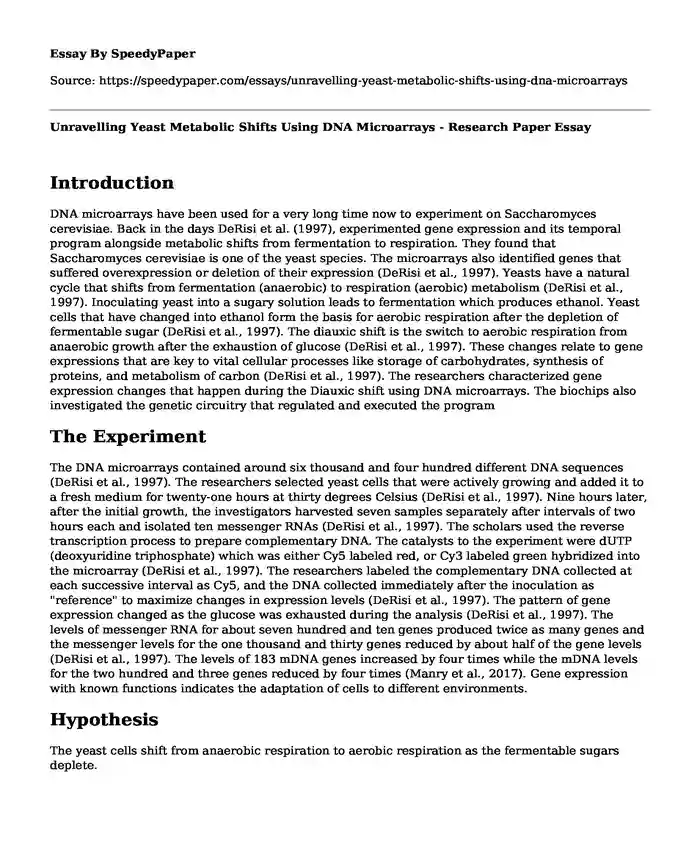
| Type of paper: | Research paper |
| Categories: | Biology |
| Pages: | 3 |
| Wordcount: | 735 words |
Introduction
DNA microarrays have been used for a very long time now to experiment on Saccharomyces cerevisiae. Back in the days DeRisi et al. (1997), experimented gene expression and its temporal program alongside metabolic shifts from fermentation to respiration. They found that Saccharomyces cerevisiae is one of the yeast species. The microarrays also identified genes that suffered overexpression or deletion of their expression (DeRisi et al., 1997). Yeasts have a natural cycle that shifts from fermentation (anaerobic) to respiration (aerobic) metabolism (DeRisi et al., 1997). Inoculating yeast into a sugary solution leads to fermentation which produces ethanol. Yeast cells that have changed into ethanol form the basis for aerobic respiration after the depletion of fermentable sugar (DeRisi et al., 1997). The diauxic shift is the switch to aerobic respiration from anaerobic growth after the exhaustion of glucose (DeRisi et al., 1997). These changes relate to gene expressions that are key to vital cellular processes like storage of carbohydrates, synthesis of proteins, and metabolism of carbon (DeRisi et al., 1997). The researchers characterized gene expression changes that happen during the Diauxic shift using DNA microarrays. The biochips also investigated the genetic circuitry that regulated and executed the program
The Experiment
The DNA microarrays contained around six thousand and four hundred different DNA sequences (DeRisi et al., 1997). The researchers selected yeast cells that were actively growing and added it to a fresh medium for twenty-one hours at thirty degrees Celsius (DeRisi et al., 1997). Nine hours later, after the initial growth, the investigators harvested seven samples separately after intervals of two hours each and isolated ten messenger RNAs (DeRisi et al., 1997). The scholars used the reverse transcription process to prepare complementary DNA. The catalysts to the experiment were dUTP (deoxyuridine triphosphate) which was either Cy5 labeled red, or Cy3 labeled green hybridized into the microarray (DeRisi et al., 1997). The researchers labeled the complementary DNA collected at each successive interval as Cy5, and the DNA collected immediately after the inoculation as "reference" to maximize changes in expression levels (DeRisi et al., 1997). The pattern of gene expression changed as the glucose was exhausted during the analysis (DeRisi et al., 1997). The levels of messenger RNA for about seven hundred and ten genes produced twice as many genes and the messenger levels for the one thousand and thirty genes reduced by about half of the gene levels (DeRisi et al., 1997). The levels of 183 mDNA genes increased by four times while the mDNA levels for the two hundred and three genes reduced by four times (Manry et al., 2017). Gene expression with known functions indicates the adaptation of cells to different environments.
Hypothesis
The yeast cells shift from anaerobic respiration to aerobic respiration as the fermentable sugars deplete.
General Finding
Large gene-related functionalities provide insights into how yeast cells adapt systematically to changing environments just as gene expressions show insights of metabolic reprogramming (DeRisi et al., 1997). Vastly altered gene expressions highlighted the challenges in comprehending the current regulatory mechanism. Few cases of the experiment had discrepancies while the gene expression changes in diauxic shifts integrated much information about the cell's metabolic state and its nutritional state and were very complex (DeRisi et al., 1997). The microarrays allowed the researchers to monitor expressions in most genes under the experiment's condition (DeRisi et al., 1997). While DNA microarrays characterized the mutations' transcriptional consequences, they affected the activities of regulatory molecules (Manry et el., 2017). The microarrays enable scientists to monitor patterns of gene expressions on a genomic scale. Simple biological experiments produce a lot of information about genes and their complexity. The scholars amplified more than six thousand genes in four months, and within a couple of days, they required one hundred and ten microarrays to print each of the 6400 elements (DeRisi et al., 1997). The use of DNA microarrays in monitoring gene expressions is a practical application to screening of drugs since mutations in some encoded genes may indicate whether the drug will surrogate as a modulator or a chemical inhibitor (DeRisi et al., 1997).
References
DeRisi, J. L., Iyer, V. R., & Brown, P. O. (1997). Exploring the metabolic and genetic control of gene expression on a genomic scale. Science (New York, N.Y.), 278(5338), 680–686. https://doi.org/10.1126/science.278.5338.680
Manry, J., Nédélec, Y., Fava, V. M., Cobat, A., Orlova, M., Van Thuc, N., & Schurr, E. (2017). Deciphering the genetic control of gene expression following Mycobacterium leprae antigen stimulation. PLoS genetics, 13(8), e1006952. https://journals.plos.org/plosgenetics/article?id=10.1371/journal.pgen.1006952&rev=2
Cite this page
Unravelling Yeast Metabolic Shifts Using DNA Microarrays - Research Paper. (2023, Sep 30). Retrieved from https://speedypaper.net/essays/unravelling-yeast-metabolic-shifts-using-dna-microarrays
Request Removal
If you are the original author of this essay and no longer wish to have it published on the SpeedyPaper website, please click below to request its removal:
- Essay Sample on How Is Petroleum Formed
- Essay Sample Describing Weather History and Geology of Pali Hawaii
- Essay Sample on Alternatives Beyond Physical Scientific Reasoning
- Free Essay - Ripples of the Electron Transport
- Egypt Is a Gift of the Nile - Paper Example
- Essay Example: The Importance of Predator-prey Relationships for a Healthy Ecosystem
- Essay Sample on Forensic Procedures to Collect Forensic Evidence from Digital Devices
Popular categories




